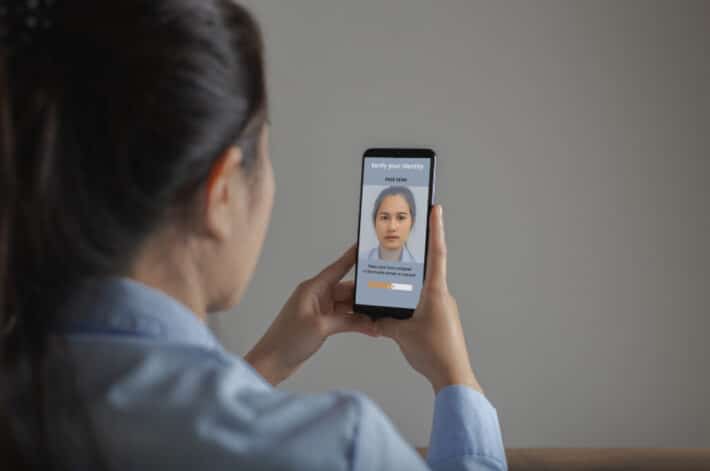Identity Verification Strategies For Combating Synthetic Identity Fraud

In the contemporary digital landscape, the prominence of identity fraud poses a significant threat, as malefactors persistently devise new methods to exploit personal information for financial motives. One emerging technique that has gained traction is synthetic identity fraud. It is imperative to comprehend the nature of synthetic identity fraud and discern its distinctions from conventional identity theft.
This discourse will address the significance of identity verification, identity verification strategies for combating synthetic identity fraud, and delineate measures for safeguarding businesses and consumers. Furthermore, it will examine the future trajectory of identity verification, encompassing technological advancements and collaborative initiatives between governmental entities and the private sector.
Therefore, brace yourself for an in-depth exploration of the realm of identity verification and the ongoing battle against fraudulent activities.
What is Synthetic Identity Fraud?
Synthetic Identity Fraud represents a highly sophisticated form of fraudulent activity in which wrongdoers fabricate an entirely new identity by amalgamating authentic and falsified personal data. This blending of real and fabricated information poses a considerable challenge for conventional Identity Verification systems in terms of detection.
Perpetrators of this type of fraud frequently leverage a combination of genuine particulars, such as valid social security numbers, and erroneous details like fictitious addresses or employment histories. Through the interweaving of these elements, they construct a seemingly legitimate identity that eludes typical fraud identification mechanisms. This intricate network of deceit presents notable obstacles for financial institutions and regulatory bodies tasked with distinguishing between authentic and synthetic identities. Consequently, these challenges can lead to substantial monetary losses and potential harm to reputations within the industry.
How is it Different from Traditional Identity Theft?
In contrast to Traditional Identity Theft, which involves the illicit acquisition and utilization of an individual’s personal information, Synthetic Identity Fraud encompasses the fabrication of new identities by amalgamating genuine and falsified information.
This differentiation is pivotal in comprehending the diverse strategies employed by fraudsters and the obstacles confronted by organizations in thwarting such deceptive activities. While Traditional Identity Theft focuses on the direct exploitation of an individual’s existing personal data for immediate benefits, Synthetic Identity Fraud is characterized by its intricate and misleading nature. It entails the construction of entirely novel identities that might not immediately trigger suspicion. Consequently, the identification and prevention of Synthetic Identity Fraud pose distinct challenges, given that these synthetic identities can exhibit an appearance of legitimacy and gradually establish credit histories before inflicting substantial financial repercussions.
Why is Identity Verification Important?
Identity verification plays a critical role in fraud prevention and the fight against identity theft, offering vital security measures to safeguard individuals and organizations from fraudulent activities.
In both online and in-person encounters, verifying the authenticity of an individual’s identity is of utmost importance in the contemporary digital era. Through the implementation of robust verification techniques like biometric identification, document authentication, and knowledge-based authentication, organizations can efficiently confirm the identities of their customers or users. These measures serve not only to deter fraudulent transactions but also to cultivate trust and credibility, fostering a secure environment for all stakeholders.
What are the Strategies for Combating Synthetic Identity Fraud?
The effective strategies for combating synthetic identity fraud encompass a blend of elevated identity verification processes, sophisticated fraud detection technologies, and collaborative initiatives across industries to guarantee comprehensive fraud prevention.
1. Strengthening Verification Processes
Enhancing verification processes is essential in mitigating the risk of fraudulent applications and ensuring the authentication of solely legitimate identities within any system.
The implementation of multi-layered verification checks stands as a highly effective approach to strengthening identity verification procedures. By integrating diverse factors such as biometric scans, behavioral analytics, and document verification, organizations can establish a resilient system that significantly diminishes the likelihood of fraudulent activities. The enforcement of stringent documentation requirements plays a pivotal role in validating individuals’ authenticity and minimizing the prospect of fraudulent applications slipping through undetected. These methodologies collectively set a high standard for identity verification and contribute to upholding the integrity of the verification process.
2. Implementing Multi-Factor Authentication
The implementation of Multi-Factor Authentication (MFA) enhances the security of the Identity Verification process by introducing an additional security layer that complicates attempts by fraudsters to circumvent security measures.
By mandating users to provide multiple forms of verification, including passwords, biometrics, or security tokens, MFA significantly decreases the likelihood of unauthorized access. This methodology not only bolsters security but also instills greater confidence in both businesses and individuals. With MFA operational, even if one element is compromised, the supplementary layers function as a protective mechanism, ensuring the safeguarding of sensitive information.
Organizations spanning various sectors are progressively integrating MFA into their security protocols to reinforce defenses against evolving cyber threats. These organizations acknowledge the pivotal role MFA plays in upholding data privacy and preserving the integrity of their systems.
3. Utilizing Biometric Technology
The utilization of biometric technology in identity verification represents an effective approach to combatting fraudulent identities through the utilization of distinctive biological characteristics, such as fingerprints and facial recognition.
Biometric authentication presents a remarkably secure method of confirming an individual’s identity, given the challenging nature of replicating or counterfeiting these unique biological markers. Through the use of fingerprints, facial recognition, iris scans, voice recognition, or palm veins, systems can accurately verify an individual’s identity with a high level of confidence.
This implementation aids in the prevention of fraud and unauthorized access by virtue of the unique nature of biometric data, which is specific to each person, rendering it exceedingly arduous for impostors to gain access through impersonation. The integration of biometric authentication into existing systems serves to bolster security protocols and furnish a more dependable mechanism for identity verification.
4. Monitoring Social Media and Online Activity
The monitoring of Social Media and Online Activity can offer valuable insights for Fraud Detection by aiding in the identification and tracking of suspicious patterns that may be indicative of Synthetic Identity Fraud.
Through the analysis of social media and online activity, a variety of techniques, such as keyword monitoring, sentiment analysis, and network analysis, can be employed to detect potential fraudulent activities. Data points to be observed include communication patterns, account creation frequency, IP addresses, and geolocation data.
These insights can then be utilized to establish baseline behavior profiles, identify anomalies, and formulate proactive fraud prevention strategies to protect against emerging threats in the digital landscape.
5. Collaborating with Other Organizations
It is imperative to engage in collaboration with other organizations to effectively prevent fraud, facilitating the exchange of information and best practices to proactively combat fraud and ensure adherence to regulatory requirements.
Through collaborative efforts between organizations, there is a valuable opportunity to harness the collective knowledge and resources available to identify patterns and trends indicative of fraudulent activities. By fostering a culture of information sharing and mutual insights, organizations can establish a more resilient defense mechanism against a spectrum of fraudulent schemes.
Joint endeavors, such as cross-industry task forces and information-sharing networks, serve a vital function in the identification and mitigation of evolving fraud risks. Conformance to industry-established standards and best practices serves to optimize the efficiency and precision of fraud detection processes, ultimately serving to safeguard businesses and consumers from potential financial losses.
How Can Businesses and Consumers Protect Themselves?
Both businesses and consumers must implement proactive security measures and protect their personal information to mitigate the risk of fraudulent activities associated with Synthetic Identity Fraud.
1. Regularly Monitor Credit Reports and Bank Statements
Regularly monitoring credit reports and bank statements plays a crucial role in fraud detection, enabling individuals to promptly detect any unauthorized activities and take immediate action.
Consistent monitoring is essential for safeguarding one’s financial assets. By diligently reviewing financial statements on a regular basis, discrepancies and unusual transactions indicative of fraudulent behavior can be identified.
An effective review process involves scrutinizing each line item for accuracy and consistency. Should any suspicious activities be observed, it is imperative to respond promptly by notifying the financial institution, freezing accounts, and reporting the matter to the appropriate authorities.
By taking these proactive measures, potential losses can be mitigated, and one’s financial well-being can be safeguarded.
2. Be Wary of Suspicious Emails and Phone Calls
It is imperative to exercise caution when encountering suspicious emails and phone calls to mitigate the risk of Identity Theft and identify instances of fraudulent activity, as these are prevalent tactics employed by malicious actors for the purpose of extracting personal data.
Phishing emails often masquerade as communications from reputable entities, such as financial institutions or established corporations, urging recipients to interact with a link or download an attachment. Conversely, vishing entails the receipt of fraudulent phone calls wherein scammers attempt to deceive individuals into divulging confidential information. These schemes can exhibit a high level of sophistication, incorporating intricate facades to appear authentic.
To enhance one’s security posture, it is recommended to consistently authenticate the legitimacy of the sender prior to engaging with any hyperlinks or disclosing personal information via telephone conversations.
3. Use Strong and Unique Passwords
The utilization of strong and unique passwords for all online accounts is a foundational security measure that significantly enhances fraud prevention by increasing the complexity of unauthorized access for fraudulent individuals.
Creating distinct passwords for each account is imperative. If a cybercriminal acquires one password, they could potentially gain access to all accounts if the same password is used across multiple platforms. To facilitate the effective management and security of passwords, the adoption of password manager tools is recommended. These tools have the capability to produce intricate and randomized passwords for each account, securely store them, and automatically populate them when necessary.
By integrating these practices into one’s online security protocol, the safeguarding of sensitive information against potential data breaches and identity theft is strengthened.
4. Keep Personal Information Secure
Ensuring the security of personal information is of utmost importance in mitigating the risks of identity fraud. This necessitates individuals to adhere to best practices when handling and exchanging sensitive data.
This involves exercising caution when divulging personal information on websites, particularly those lacking adequate security measures. Users can strengthen security measures by using robust and distinct passwords when creating online accounts. Additionally, regularly monitoring financial accounts and credit reports for any irregular activities can aid in the prompt detection of potential fraudulent activities.
In the physical realm, the disposal of important documents should involve shredding to prevent unauthorized access to sensitive information. Furthermore, individuals should exercise caution when sharing personal information over the phone or in response to unsolicited emails to safeguard their personal data. By maintaining vigilance and taking proactive measures, individuals can significantly mitigate the likelihood of falling prey to identity theft.
What is the Future of Identity Verification?
The future of Identity Verification hinges on the progression of technologies such as Artificial Intelligence, Machine Learning, and Biometric Authentication. These advancements hold the potential to augment the precision and effectiveness of verifying digital identities and identifying instances of fraud.
1. Advancements in Artificial Intelligence and Machine Learning
Advances in Artificial Intelligence (AI) and Machine Learning are transforming Fraud Detection and Identity Verification processes by facilitating more sophisticated data analysis and identification of fraudulent patterns.
These technologies have broad applicability across diverse industries such as financial services, e-commerce, healthcare, and others, serving to fortify security protocols.
In the realm of Identity Verification, AI and Machine Learning algorithms can swiftly validate individuals via biometric data, facial recognition, and behavioral analysis, thereby augmenting user authentication procedures. By swiftly identifying any abnormal behavior or inconsistencies in real-time, these technologies play a pivotal role in thwarting identity theft and unauthorized access. Their proactive approach is instrumental in safeguarding sensitive data and mitigating the vulnerabilities linked with fraudulent behaviors.
2. Increased Use of Biometric Technology
Experts anticipate that the increasing utilization of biometric technology will play a significant role in shaping the future of identity verification by providing advanced security mechanisms based on distinctive biological characteristics.
Biometric technologies encompass a variety of methods, including fingerprint recognition, iris scanning, facial recognition, and voice authentication. Additionally, each of these biometric modalities serves as a secure and efficient means of verifying an individual’s identity. Apart from bolstering security measures, the integration of these technologies can streamline authentication procedures, mitigate instances of fraud, and enhance the overall user experience. The inherent uniqueness of an individual’s biological traits significantly hampers unauthorized access or identity theft, positioning biometric technology as an essential asset in contemporary security frameworks.
3. Collaboration between Government and Private Sector
The collaboration between the government and the private sector is imperative for advancing identity verification practices and ensuring regulatory compliance, promoting a cohesive strategy in the fight against fraud. By combining efforts and sharing resources and expertise, both entities can capitalize on their respective strengths to develop more sophisticated fraud prevention methodologies.
In this partnership, the government can offer valuable insights into emerging fraud trends, while the private sector can contribute innovative technologies and specialized knowledge.
This collaboration not only enhances the effectiveness of identity verification systems but also bolsters the overall security protocols in place to safeguard individuals’ sensitive data. Through mutual cooperation, these organizations can establish resilient safeguards that proactively address fraudulent activities and uphold the integrity of identity verification processes.
Frequently Asked Questions
What is synthetic identity fraud and why is it a concern?
Synthetic identity fraud is a type of identity theft that involves creating a new identity using a combination of real and fake information. Additionally, this makes it difficult for traditional identity verification methods to detect and poses a significant risk for businesses and individuals.
What are some common strategies for combating synthetic identity fraud?
Some common strategies for combating synthetic identity fraud include identifying suspicious patterns in credit and application data, implementing biometric authentication, and utilizing machine learning algorithms to detect anomalies.
How can businesses adapt their identity verification processes to combat synthetic identity fraud?
Businesses can adapt their identity verification processes by implementing multi-layered verification methods, such as verifying multiple types of personally identifiable information and conducting manual reviews of suspicious applications.
How can individuals protect themselves from becoming victims of synthetic identity fraud?
Individuals can protect themselves by regularly monitoring their credit reports and accounts for any suspicious activity, being cautious about sharing personal information, and using strong and unique passwords for their online accounts.
What role does technology play in detecting and preventing synthetic identity fraud?
Technology plays a crucial role in detecting and preventing synthetic identity fraud. Additionally, from advanced algorithms and biometric authentication to data analytics and artificial intelligence, technology helps businesses stay ahead of fraudsters and protect against identity theft.
How can businesses stay updated on the latest strategies for combating synthetic identity fraud?
Businesses can stay updated on the latest strategies for combating synthetic identity fraud by regularly consulting with fraud prevention experts, attending industry conferences and webinars, and staying informed about new technologies and fraud trends.



